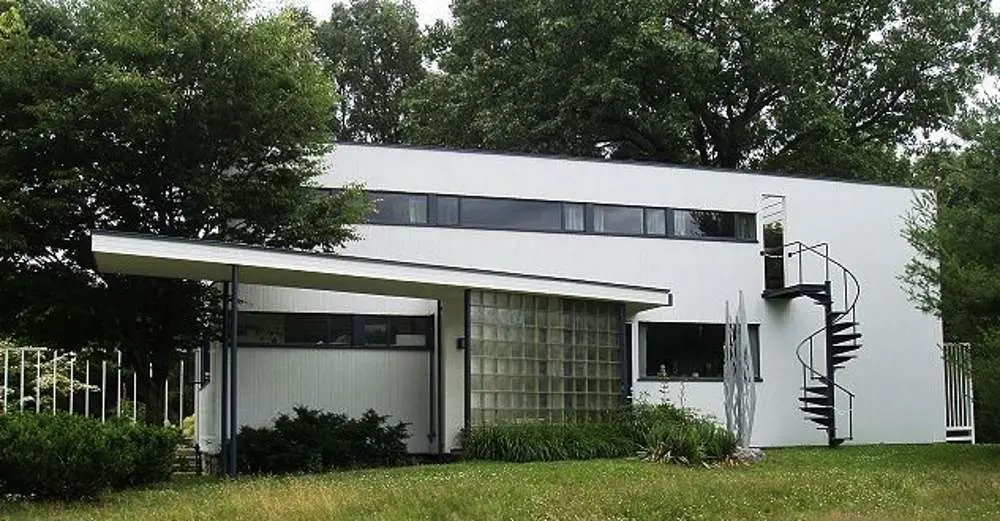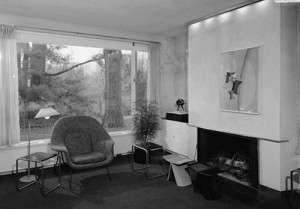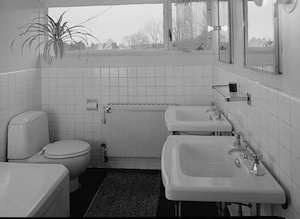The Gropius House stands as a symbol of modern architecture in Lincoln, Mass. But in 1937, Lincoln itself was a symbol of freedom to Walter Gropius, a German architect who had fled the country during World War II.
Gropius and his wife lived in London for three years after leaving Germany with only their possessions. When Harvard appointed Gropius to its faculty, the couple gravitated toward the historic town. Many of the people who lived in Lincoln descended from the Americans who had fought at Lexington and Concord.
“We began looking around for a house in the beautiful countryside of Boston,” wrote Ise, “and tried to rent a small house in Lincoln, one of the three towns… that had been the site for the first battle for independence…
“Freedom,” however, did not mean dressing up in period-era clothing for battlefield reenactments or buying an 18th-century home and filling it with Colonial Revival furniture. It meant designing a modern house in the style of the Bauhaus, the German modernist school that Gropius had founded.
The Gropius House
But Walter Gropius couldn’t afford to build a house.
As luck would have it, Gropius and his wife attended a dinner party held by Helen Osborne Storrow, a philanthropist and wife of James J. Storrow, a prominent banker. She was intrigued by Gropius, who would soon head Harvard University’s Graduate School of Design. So she gave him a piece of land to build on and loaned him the money for the house.
Gropius built a simple, efficient contemporary home that melded industrial and traditional New England architectural materials. He used a fieldstone foundation, white painted wood, a brick chimney and a screened-in porch. Many of the fixtures were ordered from catalogs. It cost $18,000 to build. He explained what he was trying to do:
…I made it a point to absorb into my own conception those features of the New England architectural tradition that I found still alive and adequate. This fusion of the regional spirit with a contemporary approach to design produced a house that I would never have built in Europe with its entirely different climatic, technical and psychological background.
Gropius also believed that an architect should work with the user to design a building. He consulted his 12-year-old adopted daughter Ati about her bedroom. She wanted to bring her friends directly to her room, so Gropius added a metal spiral staircase to the front of the house — near a large window, so adults could see who was coming and going. He even designed treads that scraped the dirt off the children’s shoes.
Many of the Gropiuses’ adult friends visited them in Lincoln, including Alexander Calder, Joan Miro, Henry Moore and Frank Lloyd Wright.
Avant-garde Weimar
When finished, the Gropius House created a sensation. Composer Igor Stravinsky, lecturing at Harvard, was so anxious to see it that he and his new bride visited it scarcely an hour after their wedding in March 1940. “A taste of avant-garde Weimar within walking distance of Walden Pond,” gushed one critic.
Mrs. Storrow was so pleased she let three other Harvard professors build Modernist houses on her land. She made the same arrangement with Marcel Breuer that she made with Gropius. Breuer built a house next door.
Not everyone liked it. A neighbor, James Loud, called it a chicken coop. Some questioned its durability — until the house came through the New England hurricane of 1938 with minimal damage.
Walter Gropius lived in the house until he died on July 5 1969 at the age of 86. In 1974, his wife Ise donated it to the Society for the Preservation of New England Antiquities, and lived in it until her death in 1983.
In 2000, the Gropius House was declared a National Historic Landmark. It is now owned by Historic New England and is open to the public Wednesday through Sunday (June 1 – October 15, and weekends (October 16 – May 31).
This story was updated in 2022.





5 comments
[…] The school quickly grew too crowded and a new school was built in 1878. By 1963 it was outdated, and a competition was held to design a new one. The winning design was by the local firm Harkness & Geddes in collaboration with Boston architect Walter Gropius. […]
[…] Rudolph, who studied with Walter Gropius at the Harvard Graduate School of Design, in 1963 designed the Brutalist Art and Architecture […]
[…] Like most of New England’s wealthiest towns, New Canaan has preserved some of its colonial buildings. But the town has an unusual concentration of mid-century modern homes, such as Philip Johnson’s Glass House. A group of modern architects known as the Harvard Five lived and worked in New Canaan, all followers of Bauhaus architect Walter Gropius. […]
[…] Philip Johnson designed the Glass House in 1949 as a weekend retreat in New Canaan, an upscale suburb of New York. Johnson belonged to a group of modern architects known as the Harvard Five, who lived and worked in the town. They all followed Walter Gropius. […]
[…] Helen Storrow, a wealthy Boston philanthropist, supported the North Bennet Street Industrial School. A North End trade school, it gave classes to young immigrants in printing, stone carving, woodwork, cement work, sewing and dressmaking. […]
Comments are closed.